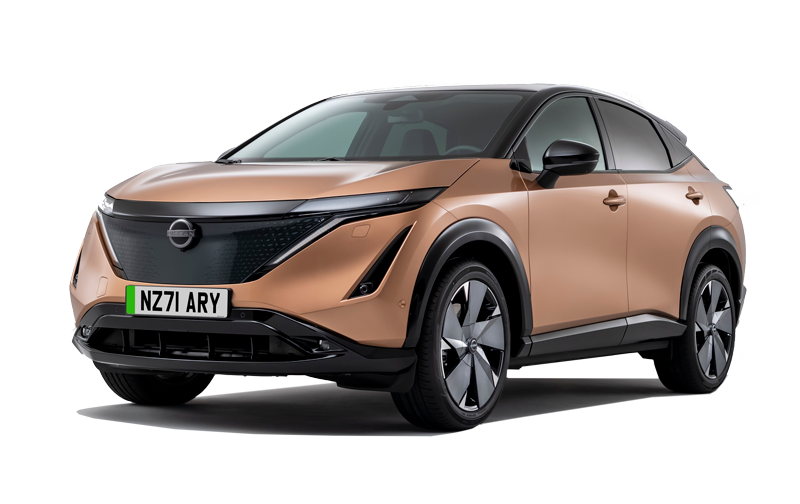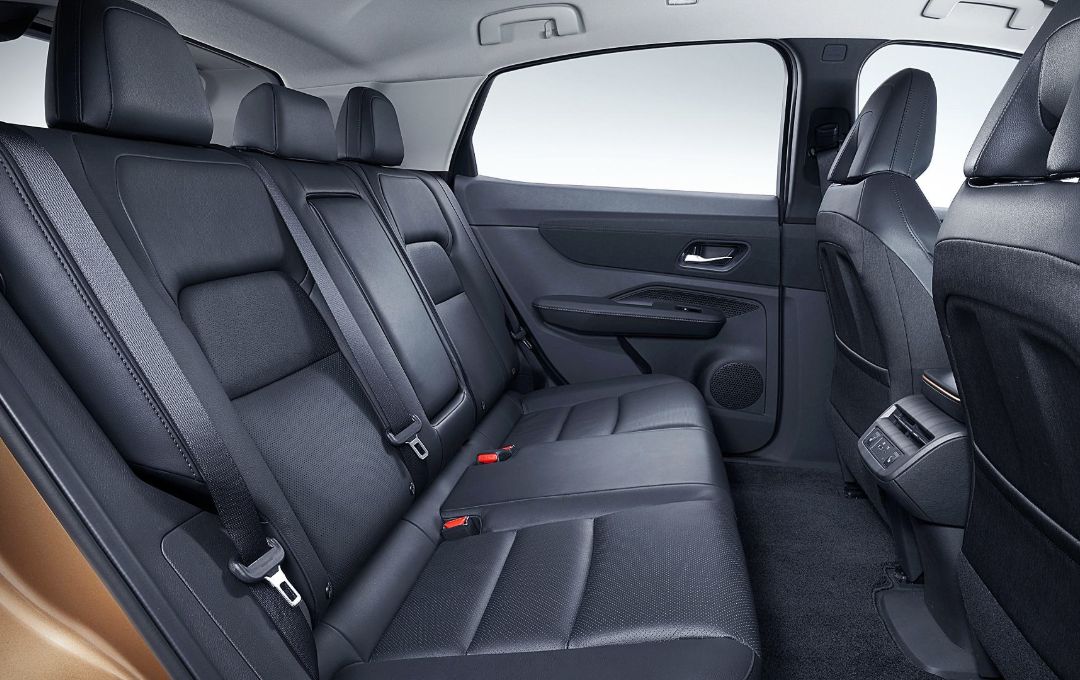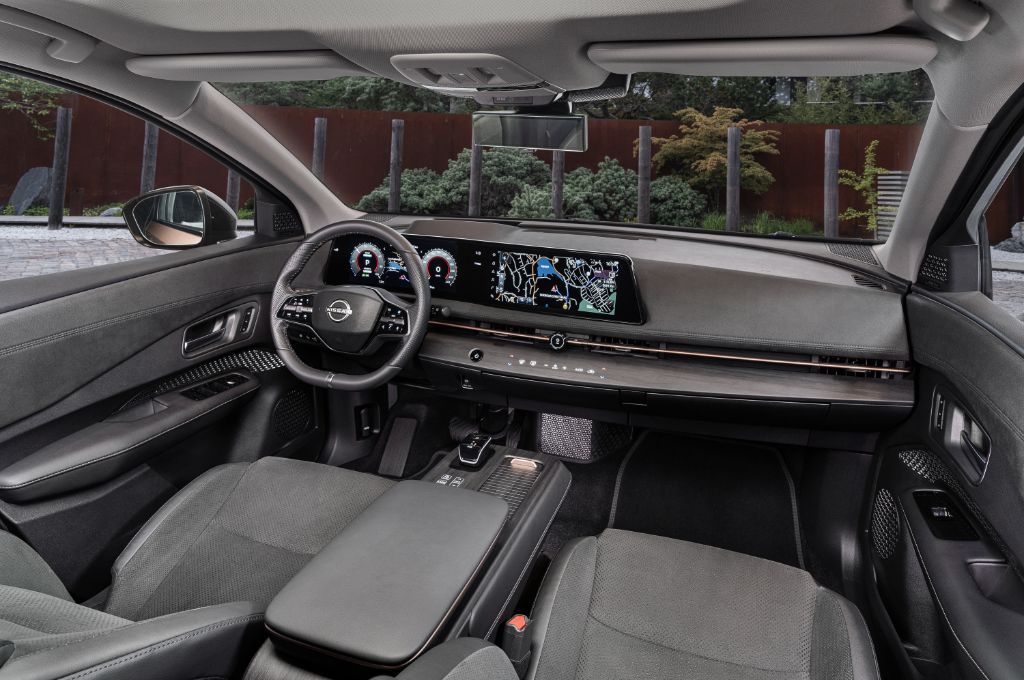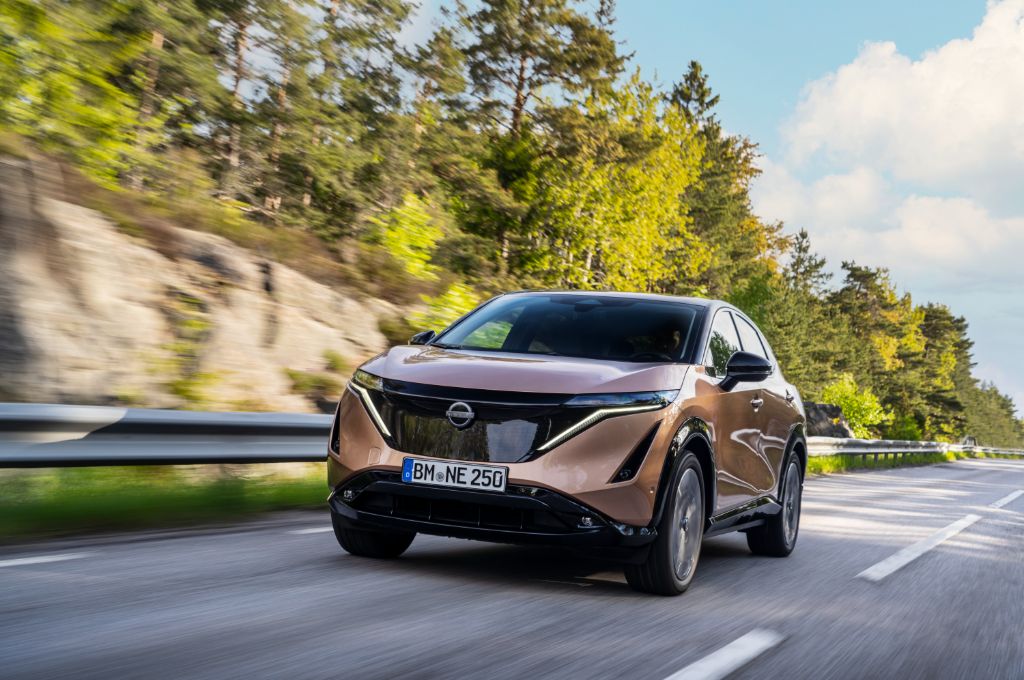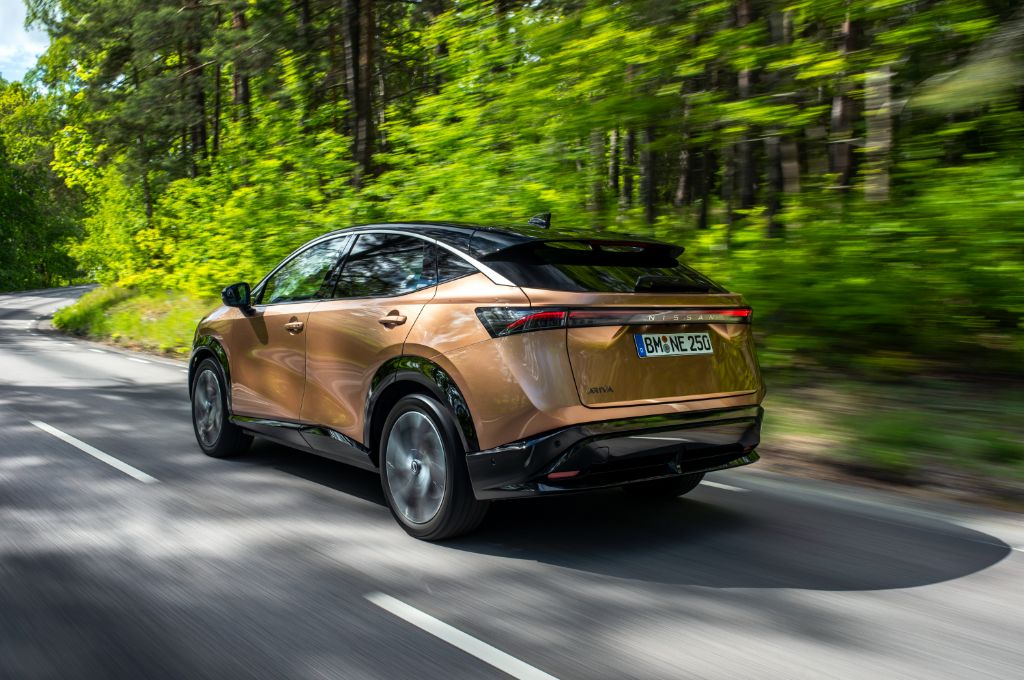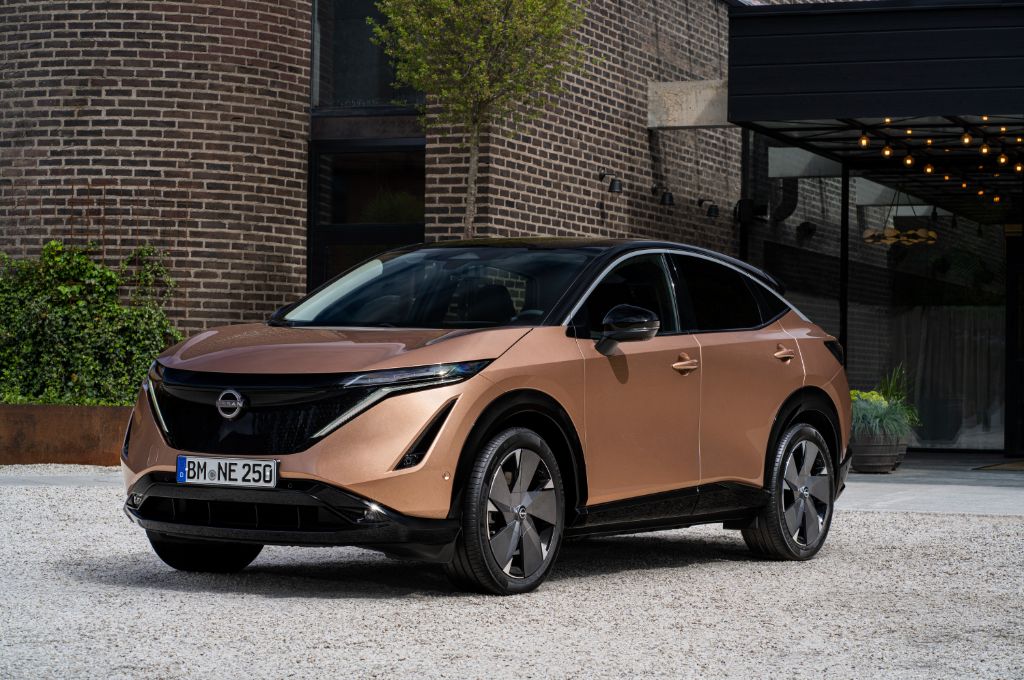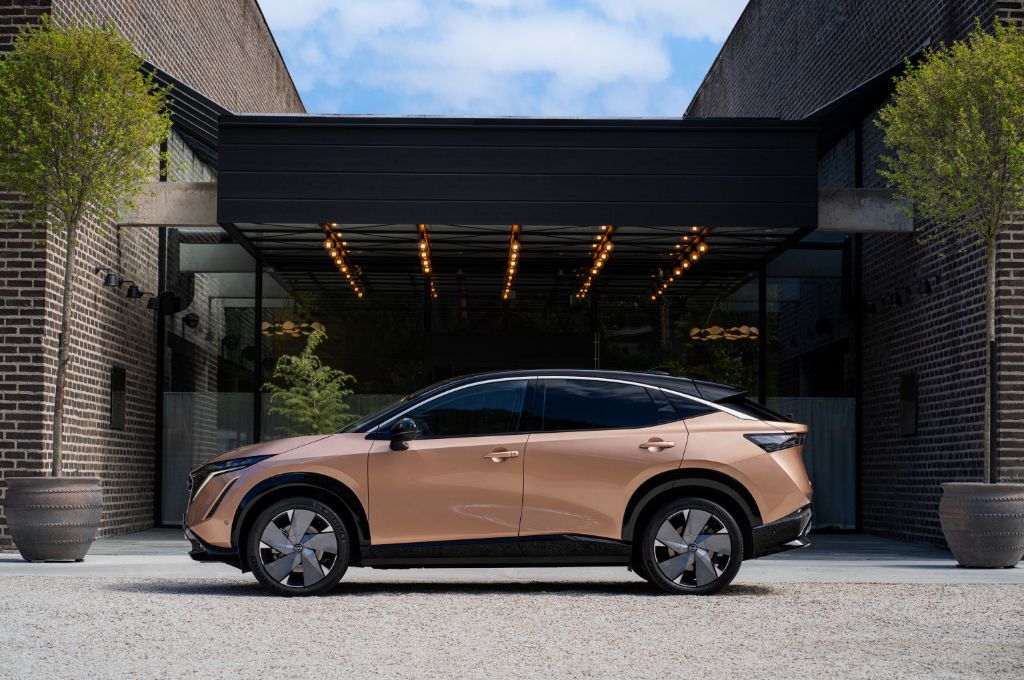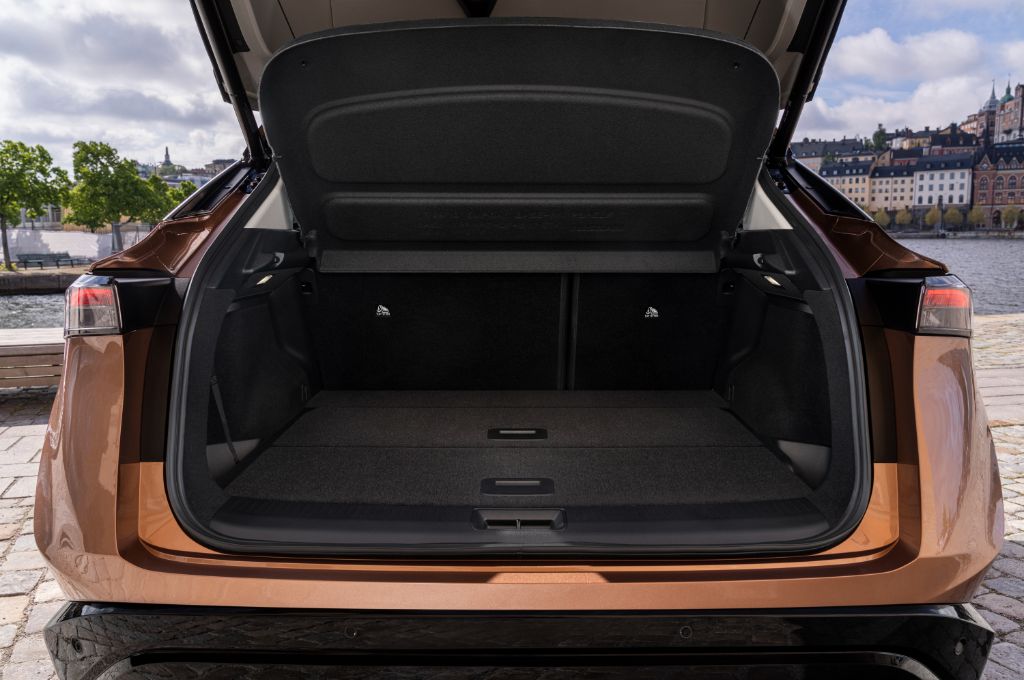What is the Nissan Ariya?
The new Ariya sits above the existing LEAF model and takes the form of a family-sized SUV. Nissan is hoping to tap into the vast global market for medium-sized electric SUVs and is aiming squarely at the likes of the Volkswagen ID.4 (and ID.5), ŠKODA Enyaq iV and Tesla Model Y.
At just over 4.5 metres long and 1.8 metres wide, the new Ariya is almost identical in size to the cars it will be competing with. In terms of design, the newcomer marks a stark departure from the neat but somewhat functional LEAF, introducing a slick, flowing look that, according to Nissan, sets the new template for the brand’s next generation of electric cars. Which is good news.
It’s built on a new set of underpinnings (known as the CMF-EV platform) that it will share with the new Renault Megane E-Tech. The platform is essentially a universal floor, battery pack and motor assembly onto which Nissan and Renault design and build their respective cars.
Even in the odd but curiously alluring metallic browny orange of the launch cars (officially called Akatsuki Copper), the Ariya looks a handsome package. The large (fake) grille and contrasting roof and pillars cleverly hide the bulk of the car, as do the enormous 20-inch wheels with matching wheel arch extensions.
Inside, the Ariya’s flat floor makes for a vast cabin with plenty of space for passengers. The dashboard is simple but neatly executed with all the displays arranged in a single screen assembly that spans just over half of the dashboard. There's plenty of adjustment on the steering column and seat, and finding a comfortable driving position is easy. Touch-sensitive buttons are integrated into a wood-effect strip that spans the width of the car while the centre console slides back and forth to allow drivers to maximise the floor space. It all looks and feels remarkably high end, from the copper metal strips along the dash rail to the fabric panels above them. The Ariya is priced as a premium product and in terms of interior fit and finish, it feels like one too.
At the back, two-wheel drive versions of the Ariya have a decently-sized 466 litre boot while all-wheel drive models offer 408 litres, as a result of an extra motor robbing some of the room. That’s more than you’ll find in a new Nissan Qashqai but far less than rivals such as the ŠKODA Enyaq and Tesla Model Y can deliver.
As Nissan owners have come to expect, the Ariya will come with a host of gadgets and technology. These include ProPILOT assistance systems, the brand’s famous ePedal along with Nissan’a Safety Shield, which includes Intelligent Around View Monitor, Intelligent Forward Collision Warning, Intelligent Emergency Braking, and Rear Automatic Emergency Braking Technology.
Towing fans will also have reason to like the new Ariya. Both two and all-wheel drive versions will be homologated for towing duties with two-wheel drive versions rated at 750kg and all-wheel drive versions rated at 1,500kg.
What's it like to drive?
On the road, the entry-level 63kWh delivers a refined and comfortable ride. The steering is light and precise, and the Ariya immediately feels secure and predictable - all good things in a family SUV. There are three driving modes to choose from, Eco, Normal and Sport, and they all do pretty much what you expect; Eco softens off the responses to give you the best chance of achieving the possible 250 miles of WLTP range, 'Normal' a happy medium and Sport makes things a bit more peppy, although the modes aren’t that far apart, so most of the time the mid-setting is the best.
During our 90 minute drive on the roads surround Stockholm, we averaged an impressive 4.4 miles per kWh. However, the route was largely urban with longer stretches of 50 mph A-roads that gave us an average speed of 35mph. We’d expect that figure to fall into the mid-3s on a 70mph UK motorway stretch in the depths of winter.
The one thing the Ariya does do is feel properly light - especially with the smallest battery option - something most electric cars struggle with. It turns, stops and handles with authority, and although it’s not ‘sporty’ in any significant sense, it’s predictable and solid. Sharp acceleration can, however, cause the front tyres to squirm a little - especially out of junctions. 300Nm of torque is a lot for a for a front-wheel car to deliver smoothly, and if you’re in the habit of mashing the accelerator to the floor at every opportunity, you may need to adapt your driving style.
The front-wheel drive cars might not have the perfect 50:50 weight distribution of the e-Force versions, but they drive very nicely, probably thanks to a very low centre of gravity. And yes, there’s a light-touch ‘B’ mode for brake regeneration - when the car claws back energy during braking to add some charge to the battery - as well as proper Nissan e-Pedal (activated via a haptic button on the centre console) for more aggressive stopping power without ever touching the traditional brake pedal.
One difference here is that the system is called e-Pedal Step, so the car will creep slightly in traffic like a normal automatic car, which just adds that little bit of functionality. The Ariya simplicity itself to drive in town, and feels narrower than some of the competition - again, good for threading through traffic.
We’ll have to wait to see if the e-Force four-wheel drive cars add anything to the driving experience, but going from our experience in the base of the range and least-powerful car, the Ariya is building on a solid set of basics.
Battery, range and charging
The Ariya is available with a broad range that includes two battery size options, four power outputs and the option of front-wheel drive and all-wheel drive.
Buyers will be able to choose from 63kWh or 87kWh battery packs. The figures refer to the actual usable capacity rather than the overall size, so while the smaller pack may seem only fractionally bigger than the one offered in the 62kWh LEAF, the actual usable capacity of the LEAF pack is 56kWh.
Two-wheel drive versions can be specified with either pack with the 63kWh producing 214bhp and the 87kWh delivering 239bhp to the front wheels. Customers opting for the 302bhp all-wheel drive or (e-4ORCE) versions can only choose the larger 87kWh pack. Opt for the latter version and the 0-62mph time is just 5.7 seconds. Which will be plenty fast enough for most drivers.
In terms of the all-important range figures, the entry-level 63kWh models have a WLTP range of up to 250 miles while the 87kWh two-wheel drive models can manage up to 329 miles on a charge. The all-wheel drive models have a predicted WLTP range of 310 miles (a figure that will be confirmed pending final homologation).
All versions will be able to accept a rapid DC charge at speeds of up to 130kW, which is on a par if not fractionally quicker than its rivals with the notable exceptions of the Hyundai IONIQ 5, Kia EV6 and Tesla Model Y, all of which can charge at well over 200kW.
The 63kWh model will be able to charge from 10-80% in an estimated 31 minutes while the 87kWh version will do the same in around 35 minutes.
The arrival of the Ariya also marks the end of the road for Nissan’s association with CHAdeMO charging hardware. While the LEAF will continue to use the connector, the Ariya, along with all future Nissan electric models will use the more common CCS charging port. 63kWh versions come equipped with a 7.4kW AC charger for domestic use, 87kWh models include a 22kW three-phase charger.
How much does it cost?
The cheapest 63kWh two-wheel drive model starts at £41,845 while the range tops out with the 87kWh e-4ORCE variant with 22kWh charger at £56,290. Although that makes it look more expensive than rivals such as the Volkswagen ID.4 and ŠKODA Enyaq, Nissan claims the Ariya's resale values are predicted to be much higher than all the leading rivals, meaning the finance and lease payments for most customers will be similar to cheaper models.
In terms of equipment, the Ariya follows the Nissan tradition of offering plenty of standard kit. It launches with two trim grades, Advance and Evolve, with all models featuring ProPILOT with Navi-Link, Intelligent Driver Alertness and Lane Keep Assist, Traffic Jam Pilot, Blind Spot Intervention, Intelligent Cruise Control, Full Auto Park, Apple Car Play and 360 degree Around View Monitor.
The higher spec Evolve grade adds features such as Pro-Pilot Park, Windscreen Heads-up Display, a 10 Bose speaker system, Electric Panoramic Sunroof, power moving centre console, and black upholstery with synthetic leather seats and Ultrasuede inserts.
Pricing for the 63kWh battery version with 215bhp of power and an onboard 7.4kW AC Charger starts at £43,845 for the Advance and £47,840 for the Evolve.
For the larger 87kW battery with up to 329 miles of range, 239bhp of power and a more powerful onboard 22kW AC charger, the Advance is priced at £49,595 with Evolve at £53,590.
All-wheel drive e-4ORCE versions have a 63bhp increase in power to 302bhp and doubles the amount of torque to 600Nm. It is priced from £52,295 for the Advance grade or £56,290 for the Evolve.










